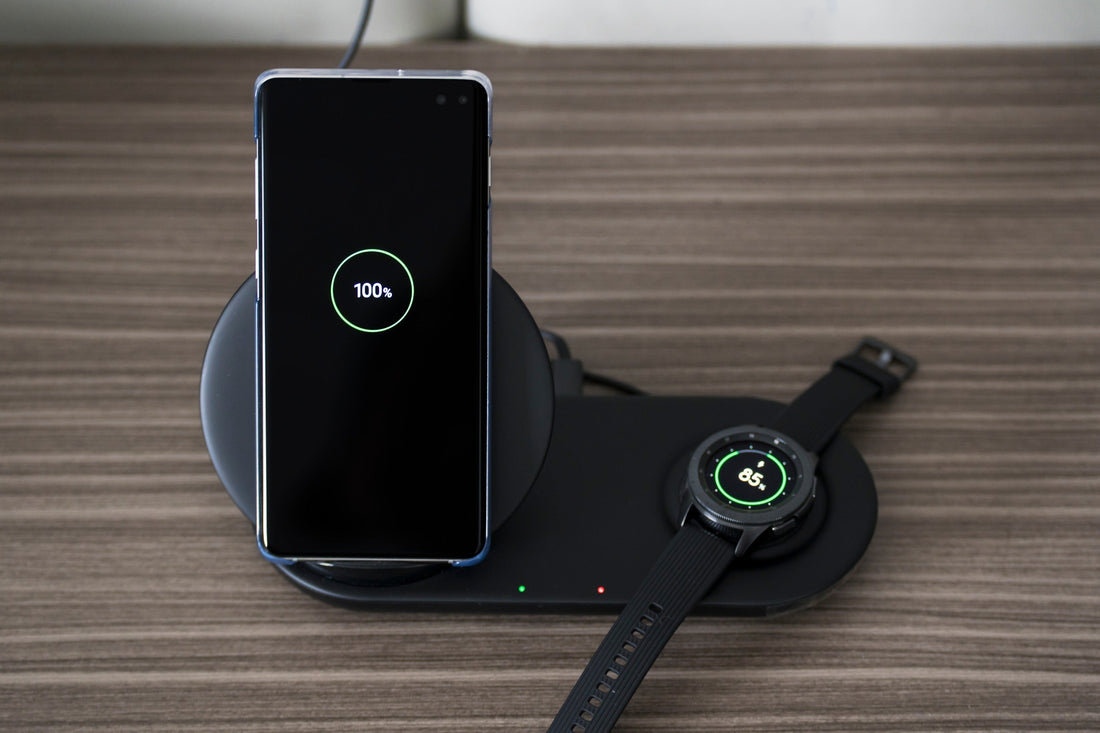
HOW DOES WIRELESS CHARGING WORK? BASICS, BENEFITS, AND TIPS
Share
 More and more devices can be charged wirelessly. The technology behind it sounds almost magical, but it is actually a well-defined physical process: the so-called inductive charging.
More and more devices can be charged wirelessly. The technology behind it sounds almost magical, but it is actually a well-defined physical process: the so-called inductive charging.
In this article, you will learn how wireless charging works, what advantages and disadvantages it offers, what standards exist, and what you should pay attention to when using it.
Definition of Wireless Charging
Wireless charging – also known as inductive charging – refers to the transfer of energy from a charger to a device such as a smartphone, without the need for direct contact via a cable. Instead, energy is transferred through an electromagnetic field from a coil in the charging station to a receiving coil in the device.
The Technology of Inductive Energy Transfer
Wireless charging is based on the principle of electromagnetic induction. The charging station contains a so-called transmitter coil, which is supplied with alternating current, creating an oscillating magnetic field. When a device with a compatible receiving coil is placed on the station, the magnetic field induces an electric voltage in the device's coil. This voltage is converted into direct current and flows directly into the battery.
For the charging process to work efficiently, the coils in both the sender and receiver must be very close to each other and properly aligned. The distance between the coils is usually only a few millimeters. Some modern chargers use a technique called resonant induction, where the coils are tuned to each other and can bridge a certain distance.
Qi Standard: The Industry Standard for Wireless Charging
Most devices that can be charged wirelessly use the Qi standard, pronounced as "chee." It was developed by the Wireless Power Consortium (WPC) and has established itself as the global standard. Qi enables not only energy transfer but also communication between the sender and receiver, allowing charging power and temperature to be monitored and controlled.
Advantages of Wireless Charging
The technology of inductive charging offers the following key benefits for users:
- Convenience: No more plugging in and unplugging cables. The device is simply placed on the station.
- Less wear and tear: The charging port on the device is preserved, which can increase its lifespan.
- Design-friendly: Charging stations can be elegantly integrated into furniture or vehicles.
- Universal use: Many chargers support multiple devices simultaneously, as long as they are Qi-compatible.
Disadvantages and Challenges
The technology of inductive charging has some significant challenges in addition to its strengths:
- Lower efficiency: Some energy is lost during transmission, so charging takes longer than with cables.
- Positioning required: The device to be charged must be correctly positioned. Even a slight misalignment can slow down or interrupt the charging process.
- Higher acquisition cost: Wireless chargers are often more expensive than traditional power adapters.
- Higher heat generation: Inductive charging generates more heat, which can impact battery performance in the long run.
Power of Wireless Charging Stations
The power of wireless chargers is measured in watts. Common models deliver between 5 and 15 watts, while newer fast chargers can provide 20 watts or more. However, the actual charging speed depends on both devices – both the charging pad and the device to be charged must support the same fast-charging technology to benefit from higher power levels.
Tips for Optimal Use
To achieve the best results when using inductive charging, follow these tips:
- Ensure a clean surface without cases with metal components.
- Place the device to be charged centrally on the station.
- Avoid extreme temperatures during charging.
- It is recommended to use certified Qi chargers from reputable manufacturers.
- If wireless charging is not possible, we recommend fast USB-C cables – provided the device supports them.
Frequently Asked Questions about Wireless Charging
How can you activate inductive charging?
In most cases, inductive charging is automatically active if the device to be charged has a built-in Qi coil. For some Android devices, the feature needs to be activated in the settings (e.g., under "Battery" or "Connections"). iPhones from model 8 onwards support Qi automatically.
How many watts should a wireless charging station have?
For standard use, charging stations with 5 to 10 watts are sufficient. Users who want fast power delivery for their devices should consider models with at least 15 watts. It is important to note that the device to be charged must also support the higher charging power.
Does inductive charging have disadvantages?
Yes, such as lower efficiency, longer charging times, potential heat generation, and higher costs. However, inductive charging offers convenience as it eliminates the need for constant plugging and unplugging of cables, and chargers can be used universally for many devices.
How much does a wireless charger cost?
Simple wireless chargers are available starting at 10 euros. High-quality charging pads with fast-charging functionality or multiple coils cost between 30 and 60 euros. Especially convenient multifunction stations for multiple devices are priced starting at 60 euros in the premium segment.
Conclusion
Wireless charging offers a practical alternative to traditional cable charging. The technology is mature and continues to be developed. It is a convenient solution for everyday use, despite some drawbacks such as energy losses or longer charging times. For those who value convenience and prefer not to have their device constantly plugged in, wireless charging provides a modern and elegant way to power devices. For situations that require maximum charging speed, fast USB-C cables remain a reliable solution.
